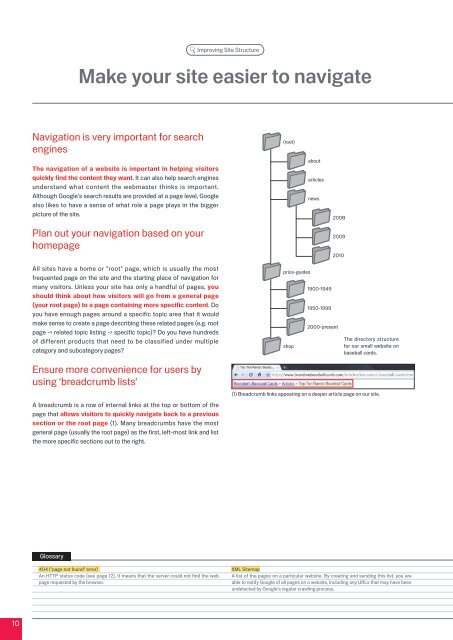Google search engine optimization starter guide
Google search engine optimization starter guide
Google search engine optimization starter guide
You also want an ePaper? Increase the reach of your titles
YUMPU automatically turns print PDFs into web optimized ePapers that Google loves.
10<br />
Improving Site Structure<br />
Make your site easier to navigate<br />
Navigation is very important for <strong>search</strong><br />
<strong>engine</strong>s<br />
The navigation of a website is important in helping visitors<br />
quickly find the content they want. It can also help <strong>search</strong> <strong>engine</strong>s<br />
understand what content the webmaster thinks is important.<br />
Although <strong>Google</strong>'s <strong>search</strong> results are provided at a page level, <strong>Google</strong><br />
also likes to have a sense of what role a page plays in the bigger<br />
picture of the site.<br />
Plan out your navigation based on your<br />
homepage<br />
All sites have a home or "root" page, which is usually the most<br />
frequented page on the site and the starting place of navigation for<br />
many visitors. Unless your site has only a handful of pages, you<br />
should think about how visitors will go from a general page<br />
(your root page) to a page containing more specific content. Do<br />
you have enough pages around a specific topic area that it would<br />
make sense to create a page describing these related pages (e.g. root<br />
page -> related topic listing -> specific topic)? Do you have hundreds<br />
of different products that need to be classified under multiple<br />
category and subcategory pages?<br />
Ensure more convenience for users by<br />
using ‘breadcrumb lists’<br />
A breadcrumb is a row of internal links at the top or bottom of the<br />
page that allows visitors to quickly navigate back to a previous<br />
section or the root page (1). Many breadcrumbs have the most<br />
general page (usually the root page) as the first, left-most link and list<br />
the more specific sections out to the right.<br />
Glossary<br />
404 ("page not found" error)<br />
An HTTP status code (see page 1 ). It means that the server could not find the web<br />
page requested by the browser.<br />
(root)<br />
price-<strong>guide</strong>s<br />
shop<br />
about<br />
articles<br />
news<br />
1900-1949<br />
1950-1999<br />
000-present<br />
008<br />
009<br />
010<br />
The directory structure<br />
for our small website on<br />
baseball cards.<br />
(1) Breadcrumb links appearing on a deeper article page on our site.<br />
XML Sitemap<br />
A list of the pages on a particular website. By creating and sending this list, you are<br />
able to notify <strong>Google</strong> of all pages on a website, including any URLs that may have been<br />
undetected by <strong>Google</strong>'s regular crawling process.

















